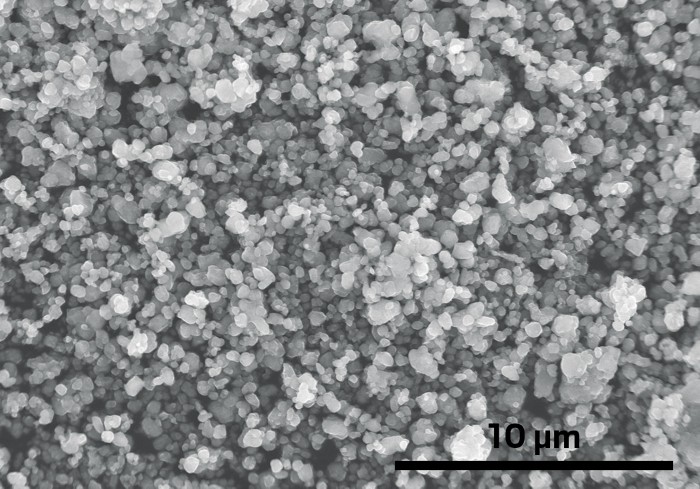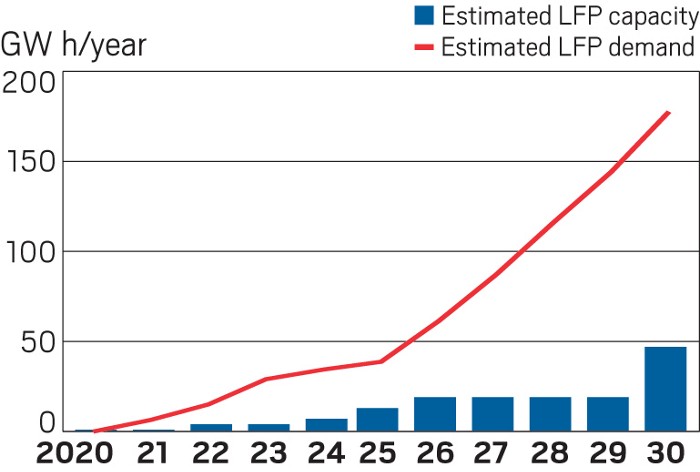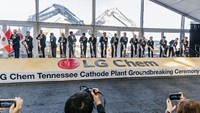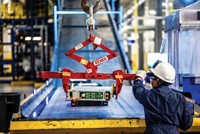Advertisement
Grab your lab coat. Let's get started
Welcome!
Welcome!
Create an account below to get 6 C&EN articles per month, receive newsletters and more - all free.
It seems this is your first time logging in online. Please enter the following information to continue.
As an ACS member you automatically get access to this site. All we need is few more details to create your reading experience.
Not you? Sign in with a different account.
Not you? Sign in with a different account.
ERROR 1
ERROR 1
ERROR 2
ERROR 2
ERROR 2
ERROR 2
ERROR 2
Password and Confirm password must match.
If you have an ACS member number, please enter it here so we can link this account to your membership. (optional)
ERROR 2
ACS values your privacy. By submitting your information, you are gaining access to C&EN and subscribing to our weekly newsletter. We use the information you provide to make your reading experience better, and we will never sell your data to third party members.
Energy Storage
Lithium iron phosphate comes to America
Companies are planning the first large-scale factories in North America for the inexpensive battery raw material
by Matt Blois
January 29, 2023
| A version of this story appeared in
Volume 101, Issue 4

Credit: David Giral Photography | Nano One Materials's Montreal factory, originally commissioned in 2012, is the only facility in North America that can produce meaningful quantities of lithium iron phosphate.
In brief
Electric car companies in North America plan to cut costs by adopting batteries made with the raw material lithium iron phosphate (LFP), which is less expensive than alternatives made with nickel and cobalt. Many carmakers are also trying to reduce their dependence on components from China, but nearly all LFP batteries and the raw materials used to make them currently come from China. A number of companies are now planning the first large-scale LFP factories in North America. Some are partnering with established companies, and others hope to introduce new technologies that will leapfrog Chinese competitors.
On a bookshelf in his home near Montreal, Denis Geoffroy keeps a small vial of lithium iron phosphate, a slate gray powder known as LFP. He made the material nearly 20 years ago while helping the Canadian firm Phostech Lithium scale up production for use in cathodes, which is the positive end of a battery and represents the bulk of its cost.
At the time, Phostech was making only about 1 metric ton (t) of LFP per year. Geoffroy mixed the precursors at a facility in Quebec and cooked the mixture in a kiln in Ontario, more than 700 km away. “Then I would put it in my car and drive home,” he says. “I would go to FedEx to ship it to customers.”
Eventually, Phostech graduated to bigger LFP factories, culminating in a 2,400 t per year plant near Montreal in 2012. Despite the progress, LFP never caught on as a chemistry for electric vehicle batteries in North America. Carmakers in the region opted instead for cathodes made with nickel and cobalt, which offer higher energy density and more range. In 2021, Johnson Matthey, which acquired the Montreal facility in 2015, put the plant up for sale.
Nickel and cobalt prices have increased substantially in the past few years, however, and nonprofit watchdogs say mining for the metals is connected to environmental problems and child labor. Nickel-based batteries are also more likely to catch fire and can’t be recharged as many times as LFP batteries.
After initially snubbing the chemistry, several big carmakers are now turning to LFP as a way to cut lithium-ion battery costs. Ford, Rivian, and Volkswagen have all unveiled plans to use LFP in North American cars, and General Motors is interested as well. A turning point came in October 2021, when Tesla, which accounted for two-thirds of US electric car registrations last year, revealed that it would switch to LFP batteries for all its standard-range vehicles globally.
Western carmakers also want to reduce their dependence on materials from China. At the moment, China is the source of nearly all LFP batteries and the cathode powders required to make them, but several companies are trying to change that.
In October, the Israeli chemical maker ICL Group announced plans to build an LFP cathode powder factory in Missouri. The Norwegian start-up Freyr Battery and Utah-based American Battery Factory plan to make LFP cathode material in the US for their battery factories in Georgia and Arizona, respectively. Meanwhile, China’s Gotion High-Tech hopes to establish LFP cathode material production in Michigan. Other Chinese manufacturers are also weighing how to leverage their expertise in North America.
In November, the start-up Nano One Materials finalized the purchase of the old Phostech LFP plant in Montreal, promising to introduce a manufacturing process that will require less energy and produce less waste than existing methods. Geoffroy, now Nano One’s chief commercialization officer, has returned to the factory to pilot the new process and scale it up.
“I designed it, built it, managed it, left it . . . and now we’re rebuilding,” Geoffroy says. “For me, it’s a chance to do what I planned on doing with a process that I believe in.”
Born in the USA
The energy powering an electric car is released when electrons from a lithium-ion battery’s negatively charged electrode, called the anode, flow through the motor into the battery’s positively charged cathode. To balance the electrons leaving the anode, the cathode must simultaneously accept positively charged lithium ions from an electrolyte solution.
Batteries with anodes that produce lots of electrons, and cathodes that are eager to suck them up, have a high voltage, which allows them to store more energy in a given volume. Energy density can be increased by using cathode and anode materials that can store more lithium ions.
Because nickel and cobalt cathode materials can store lots of lithium and generate a high voltage, they were used in some of the first commercial lithium-ion batteries. But even in the early days of battery development, researchers saw room for improvement.

“We wanted to reduce the cost, so we pursued cathodes based on iron, which is abundant and a cheaper metal,” says Arumugam Manthiram, a University of Texas at Austin researcher who worked with the battery trailblazer John Goodenough for decades and laid the groundwork for the class of cathodes that includes LFP.
In the mid-1990s, other researchers from Goodenough’s lab proposed using LFP, arguing that it was cheap and nontoxic. But the material wasn’t very conductive, which limited its utility. A few years later, building on the Goodenough lab’s initial discovery, scientists at Hydro-Québec and the University of Montreal solved the conductivity problem by coating LFP with carbon. Though LFP batteries still couldn’t match the energy density of nickel-based batteries, their lower cost made them appealing.
In 2003, Hydro-Québec and the University of Montreal gave Phostech the first license to manufacture LFP commercially. But investors backing North American projects were cautious, and progress was slow. “We had half a million dollars to survive for 3 years,” Geoffroy recalls. “I was paying myself by selling samples.”
Things accelerated for Phostech in 2005, when the German chemical company Süd-Chemie, which was developing a different LFP manufacturing process, bought a majority stake in Phostech. Süd-Chemie financed pilot facilities and the 2,400 t plant near Montreal, but the German firm’s hydrothermal process turned out to be more expensive than Phostech’s solid-state method. Clariant acquired Süd-Chemie in 2012 and promptly sold the LFP business to Johnson Matthey.
Geoffroy left Johnson Matthey in 2019 without seeing the plant become big enough to meaningfully supply the auto industry. “When we bought the land in 2007 there was expansion planned,” he recalls. “We never expanded.”
Other North American companies also sought to capitalize on the discovery of LFP, with limited success. In 2009, the Massachusetts Institute of Technology spinout A123 Systems raised $350 million in an initial public offering, aiming to manufacture a modified version of LFP in Michigan. But not enough carmakers were interested, and A123 went bankrupt in 2012. Most of the firm’s assets were acquired by China’s Wanxiang Group.
Made in China
LFP was invented and developed in North America, but Chinese companies were the first to place a big bet on the technology, according to Karim Zaghib, a battery scientist at Concordia University who worked for Hydro-Québec in the 1990s.
After successfully installing LFP batteries on buses ahead of the 2008 Beijing Olympics, China, impressed by the chemistry’s improved fire safety compared with nickel-based batteries, made LFP production a national project, Zaghib says. “The Chinese government and Chinese companies invested a lot in LFP.”
And the material has been a hit. In 2021, more than 40% of electric vehicles sold in China had LFP in their batteries, according to the market research firm Adamas Intelligence. “In China, small electric vehicles . . . with a range of 120 km are very popular,” says Alla Kolesnikova, head of data analytics at Adamas. “The majority of them are powered by LFP.”
Most factories in China produce LFP using a solid-state process that starts with the reaction of iron sulfate and phosphoric acid to produce iron phosphate. Usually the iron phosphate is then mixed with lithium carbonate and a source of carbon that forms the conductive coating.

That mixture is then sent in a ceramic crucible into a kiln, where it reaches temperatures of 700–800 °C. The heat sinters the material, changing it from an amorphous mixture into the olivine structure that allows it to function as a cathode.
Between 2010 and 2016, China’s capacity to make LFP cells, or individual battery units, increased 100-fold, according to Cormac O’Laoire, managing director of the Hong Kong–based battery consulting firm Electrios Energy. By 2021, he says, Chinese companies were producing over 90% of the world’s LFP powder.
In a little over 10 years, one Chinese company, Shenzhen Dynanonic, increased its annual LFP capacity from 500 t to 265,000 t. Unlike other firms in China, Dynanonic uses a solution-based production method that resembles the hydrothermal process Süd-Chemie used in Montreal.
Advertisement
Suki Zhang, Dynanonic’s account manager for overseas markets, says most of its growth has come in the past 2 years, a period when Chinese battery manufacturers, such as Contemporary Amperex Technology Co. Limited (CATL), were investing heavily in LFP. “We have so many batteries here,” she says. “The demand is a big reason why we built LFP in China.”
Chinese factories are able to make LFP cheaply, in part because the consortium of organizations that owned the relevant patents—including France’s National Center for Scientific Research, Hydro-Québec, Johnson Matthey, and the University of Montreal—agreed not to charge Chinese companies licensing fees if they sold only in China, according to an International Energy Agency report. In contrast, the Taiwan-based LFP maker Aleees says it paid about 10% of its sales in licensing fees until recently.
The intellectual property was held more closely in other parts of the world. “That may have limited some of the development of LFP in the US and Europe,” says Anantha Desikan, ICL’s chief technology officer.
James Frith, a principal at the venture capital firm Volta Energy Technologies, points out that China has other advantages. Iron sulfate is cheap there because it’s available as a by-product of titanium dioxide production, which isn’t the case outside China, where most makers of the pigment use a different process. Frith says less-stringent environmental regulations in China can also reduce costs.
Over the past few years, the core patents behind LFP manufacturing have expired, removing a barrier for non-Chinese companies interested in producing LFP. O’Laoire says the expirations also make it easier for Chinese companies to serve markets where the patents were previously enforced.
Zhang says Dynanonic is now considering an overseas expansion, though the company hasn’t yet disclosed a specific location. Any such project would depend on the strength of battery manufacturing in other countries as well as on the rules for implementing clean energy policies like the Inflation Reduction Act, the landmark US legislation that is projected to inject $142 billion into companies making batteries or battery components in the US.
Other Chinese battery companies have already started expanding overseas. Gotion High-Tech, which has been producing LFP batteries and cathode materials in China since 2007, plans to build 100 GW h of battery cell capacity outside China over the next 3 years. In June 2022, Gotion, whose biggest shareholder is Volkswagen, announced plans for its first LFP battery factory in Europe.

A few months later, an economic development agency in Michigan awarded Gotion’s US subsidiary grants and tax incentives to help construct a $2.4 billion plant in Big Rapids, Michigan. If built as planned, the factory will produce 150,000 t of LFP cathode material per year.
“The companies that understand how to make the product are looking to expand in other regions,” Chuck Thelen, a Gotion vice president, said at a December informational meeting hosted by Big Rapids officials.
Homecoming
Some Western firms setting up LFP cathode production in North America plan to work with partners and use established processes. Others hope to outcompete Chinese firms with new technologies.
ICL, which produces industrial phosphates and other chemicals, has been on the periphery of the LFP industry for years. It analyzed cathode materials from A123 before the company went bankrupt and began providing phosphate raw materials to LFP firms in China in 2021. In early 2022, ICL decided LFP had gained enough momentum outside China to warrant venturing into battery materials on its own.
Rising demand

In October 2022, the company received a $200 million US Department of Energy grant to build a 30,000 t per year LFP cathode material factory at its Saint Louis site, which has been producing phosphorus chemicals for more than a century. “We’ve been making phosphate salts since 1876,” says Tom Murray, ICL’s director of R&D. “Lithium iron phosphate is not very different.”
One potential difference from Chinese factories could be ICL’s starting materials. The company is evaluating using iron oxide rather than iron sulfate, which can be difficult to procure outside China. Iron oxide is more expensive, but Murray says the process produces higher-quality LFP.
At the Missouri plant, ICL will use technology from Aleees, which has been manufacturing LFP materials for nearly 2 decades. Murray says the partnership combines Aleees’s deep experience in high-quality LFP production with ICL’s expertise in large-scale chemical manufacturing. “Without them, it would be a struggle for us to jump into this and make any headway,” he says.
Eric Chang, president of Aleees’s licensing business, says the company is eager to partner with companies like ICL because its ability to expand in Taiwan is limited by the price of land. Over the last 6 months, the company has also agreed to provide its cathode manufacturing technology to Norway’s Freyr and Australia’s Avenira.
In November, Freyr announced that it would build a $1.7 billion, 34 GW h battery factory in Georgia, and Chang says Aleees plans to help Freyr make LFP cathode materials to supply that plant.
American Battery Factory, a Utah-based company that hopes to serve the stationary energy storage market, is also partnering with an established cathode manufacturer, as yet unnamed, to set up production of LFP cathode materials in the US. The powder it makes would supply the company’s proposed cell factory in Arizona and could also be sold to other companies.

Frith says China’s cheap labor, energy, and raw materials will make it difficult for Western firms to match the country’s low cost of production, but provisions in the Inflation Reduction Act may give companies in the US enough of a boost. “Without that, I think you’re unlikely to find LFP production moving outside of China,” he says. “The economics just aren’t really there to promote it.”
While Aleees’s product costs more than LFP made in China, Chang argues that the firm is better than Chinese competitors at customizing its output for specific customers. “They lack the flexibility to fine-tune the parameters or the characteristics or properties of LFP,” he says. “They make it more like a commodity rather than a specialty chemical.”
Next generation
Some Western companies are hoping to beat Chinese competitors with new technologies that can produce high-quality LFP with a lower environmental footprint.
Nano One CEO Dan Blondal says imitating China’s solid-state process in North America could be challenging because it creates lots of sulfate waste. “China largely sweeps it under the rug,” he says. “As you try to bring that out of China to everywhere else, it’s a big impediment. It’s gonna be hellish to permit that.”
Instead, Nano One plans to use pure iron metal as an LFP precursor, eliminating the sulfate waste stream. The company also claims that this method makes the cooking step more efficient, saving energy.
Nano One is just starting to set up shop at its recently purchased Montreal factory. Temporary banners with the company’s name hang from the ceiling, but the plant’s handful of employees still wear Johnson Matthey uniforms, and bags of LFP left over from the transition bear the Johnson Matthey logo.
On the factory floor, the 100 L glass reactor Nano One currently uses for its process looks small in front of the 20 m3 stainless steel reactor Johnson Matthey used to make LFP.
Geoffroy’s task is to retrofit that reactor and the rest of the Montreal facility to work with the process. The next step is to build a new factory next door to demonstrate the technology at a larger scale. While the two plants will be substantial, they will largely serve as a blueprint for still-larger plants Nano One wants to build through joint ventures or licensing deals with bigger companies.
The Montreal plant was designed for an entirely different process, so scaling up will be a long road. Pointing to a hatch at the top of a large reactor, Geoffroy says testing the Nano One process may initially require dumping raw materials in by hand.
But Geoffroy points out that he, along with much of his team, went through this twice when they built a solid-state plant for Phostech and the hydrothermal plant for Süd-Chemie. The only difference now is that the size will be much bigger. “All the LFP made in North America commercially was really made here,” he says. “All that knowledge is there. We inherit that.”

The Massachusetts start-up 6K also wants to challenge established Chinese players with a cathode material manufacturing process that uses less energy and produces less waste.
“We have to leapfrog because we can’t compete directly with the same technology,” 6K CEO Aaron Bent says. In the US, “the workforce is more expensive, electricity is more expensive,” he says. “You’ve got to have a massively differentiated approach.”
6K’s approach involves injecting a precursor mixture containing lithium, iron, and phosphorus chemicals into a microwave plasma reactor that reaches 5,700 °C. The company says the heat and reactive ions in the plasma turn the precursors into a cathode material in a matter of seconds, eliminating the need for a kiln baking step, and most of the by-products can be recycled back into the process to reduce waste.
Like ICL, 6K received a DOE grant in October. Its research center can currently produce up to 400 t of cathode material annually, and the firm hopes to build a 10,000 t plant by 2026. 6K is also working with the US battery firm Our Next Energy to install LFP cathode production capacity at a cell factory in Michigan.
Zaghib, the Concordia University battery scientist, is skeptical that new technology is the key to building an LFP ecosystem in North America. He says the solid-state process works well, and new technologies will struggle to match its price. “If we want to accelerate LFP we need GM, Ford . . . Tesla, or some government to start putting up money,” he says.
Ford hopes to partner with CATL to build LFP battery capacity locally, but in January, Virginia governor Glenn Youngkin said he had nixed a proposal for a CATL factory in his state, according to the Virginia Mercury. For now, Ford and other carmakers will rely on batteries produced in China.
Range anxiety
The companies planning to make LFP materials in North America are betting that the lower cost of LFP-powered cars will help overcome US consumers’ anxieties about their limited range, but that’s far from a guarantee. US drivers love road trips and SUVs, which typically require large-capacity batteries.
“Our driving patterns are so different from what you see in Asia and in Europe,” says Michael Sanders, a battery industry analyst with Avicenne Energy. “I think range anxiety is going to play a much bigger role here in North America.”
There are several ways around the problem. CATL and BYD Auto, another Chinese battery maker, have engineered their LFP battery packs to be hyperefficient, increasing capacity by cramming extra cathode material into the same amount of space. Ford wants to use that technology in its LFP vehicles.
It’s also possible to use a combination of battery chemistries. Our Next Energy hopes to combine a primary LFP battery suitable for everyday use with a small lithium-metal battery that could boost a car’s range when needed. Lithium-metal batteries carry more energy than other battery chemistries, but they have yet to be commercialized, in part because they degrade after a small number of charge-discharge cycles.

Another approach is simply to make iron-based batteries better. That’s what the California start-up Mitra Chem is trying to do. The company uses machine learning to create new cathode materials that combine iron with other metals, such as manganese, to increase the energy density. “We ultimately want to get to . . . LFP 2.0, LFP 3.0, higher-energy-density products that can compete . . . with nickel,” says Vivas Kumar, cofounder and CEO of Mitra Chem.
Despite LFP’s lower energy density, many analysts, including Sanders, say technology improvements and low costs mean the battery chemistry will find a place in North America. BloombergNEF says there were no US cars powered by LFP in 2020, but it expects demand for LFP-powered cars to exceed 160 GW h by the end of the decade, representing 40% of the total demand for electric cars.
When those data were published in September 2022, only a handful of companies had announced plans to build LFP factories in the US. Several have since stepped up, and Yayoi Sekine, head of energy storage at BloombergNEF, says she thinks more will come, especially as the Inflation Reduction Act encourages battery makers to build a US supply chain.
Advertisement
Geoffroy remembers when demand for LFP-powered cars was near zero in North America. About 10 years ago, when he was working at one of Phostech’s early plants, he decided to buy something made with LFP from his facility. Unfortunately, a car wasn’t an option. “I bought some small LFP batteries to power my electric trolling motor when I go fishing,” he says. “So I’m powered by LFP.”
As Nano One and other companies start building LFP factories in North America, Geoffroy is hoping for something more substantial. The moment a car built with LFP from his facility becomes available, he’s going to buy it.
CORRECTION:
This story was updated on Jan. 30, 2023, to correctly spell the name of Nano One Materials' CEO. It is Dan Blondal, not Don Blondal.





Join the conversation
Contact the reporter
Submit a Letter to the Editor for publication
Engage with us on Twitter